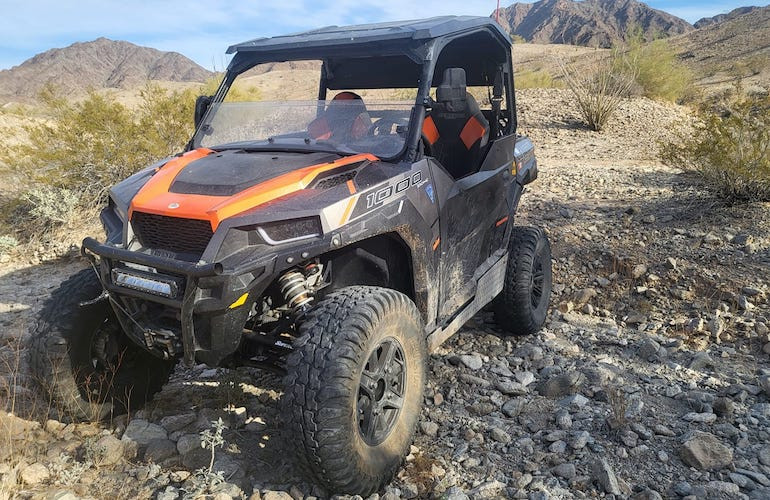What Is Considered High Mileage On A Polaris General?
Jun 15th 2023
Many riders have asked us: How many miles can you get out of a Polaris General before having to worry about critical failure in major components? And like most things, there’s not really a simple answer for this. First of all, it depends on what you consider a critical component. Is this something that makes the vehicle unusable if it fails, or is it something that’s hard / expensive to fix? Second of all, the amount of mileage you can expect from your Polaris General will also depend on both how the machine was ridden as well as how it was maintained. You would expect a vehicle in the $20K-$30K price range to go 30,000 miles without much trouble. But considering it’s an off-road toy that comes with a warranty of only 6 months, can you truly expect that many miles from a General? Here at Everything Polaris General, nuance is the name of the game. So let’s put the vagaries aside and get down to the nitty gritty to determine what is considered high mileage on a Polaris General!
In General, What Is Regarded As A High Mileage Polaris General?

Some folks ride hard and abuse their rigs – after all, you paid for the whole speedometer, so you may as well use it! Other people buy Polaris Generals for stats or show-and-tell. For the riders out there who plan on ripping it up until it is no longer possible, the theoretical odometer limit of the Polaris General is in the dozens of thousands of miles. We’ve seen several Polaris General side-by-sides with 25K+ miles on them that are still running strong, but we’ve also seen machines with sub-100 miles on them that already require a bunch of work. Unless you get unlucky with a lemon, if you take care of your machine, it’ll take care of you. But don’t expect to reach a sky-high mile number without putting in a little TLC.
Setting aside regular servicing of the engine oil, filters, and other fluids, chances are high that you won’t make it to 8,000 miles in your General without having to replace basic wear items like bushings, ball joints, and bearings. Polaris General clutches are also a common point of failure – especially with machines that see a lot of mud / water. You can help alleviate clutch fatigue by using low range as much as possible when you’re cruising under 35 MPH, and avoiding moisture is always a good idea whenever and wherever possible.
Although your engine will probably run strong well past the 10,000-mile mark, you’ll probably go through a half dozen belts, several ripped axle boots, brake pads and perhaps a fuel pump along the way. Aside from avoiding water and adhering to the servicing schedule outlined in the owner's manual, some other things you can do to increase the longevity of your UTV is add an under-hood intake pre-filter, store your bike indoors or under a storage cover, and practice responsible driving habits.
Ride in the correct range for your speed and terrain, don’t switch into or out of turf mode while in motion, and don’t shift ranges while moving either. Furthermore, don’t abuse the reverse chain, which means you should never try to pull someone out or subject your rig to any load while going backwards. Fortifying your buggy with some high-clearance a-arms, Rhino 2.0 axles, and other aftermarket upgrades can also help to make it more robust and damage-resistant!
How Many Miles Is Too Many Miles For A Used Polaris General?

When shopping for a used machine, you’ll again want to put a large emphasis on the maintenance habits of the previous owner. This can be difficult if you don’t know the person who’s selling it, and not everyone keeps a detailed papertrail of their servicing history. You can get a feel for how the UTV was maintained by checking the engine oil to see if it’s topped up and clean. Next, look at the coolant level, and do all the standard mechanical checks. Take the clutch cover off and see what things look like in there as well.
Last but not least, take the machine in question on a test drive. Listen for any weird noises, and feel for any slop, looseness, or vibrations in the steering and suspension. You can learn more about the condition of the vehicle by getting a better understanding of how / where it was driven. If you go to the buyer’s property to check it out, have a look at the surroundings. Does it appear like the vehicle was mostly used around a farm, or did the miles consist of hardcore blasting and ripping through all kinds of tough terrain including rock climbing and racing.
Also note the age of the seller, and ask if they have teenagers who have used the machine. You can also look around at their other equipment (quads, bikes, ATVs, tractors, etc.) as a guide to see how the General might have been treated. If the other machines are stored indoors and look clean with little damage, chances are high that General was kept in a similar state. Conversely, f the other toys / tools are left outside in the sun, rain, and snow – and not even hosed off with lots of dry / caked-on mud – then it’s highly probable that the General was treated poorly as well.
Conclusion

A Polaris General with 10K miles on it is like a middle-age human. Does it have its whole life ahead of it? No. But can it keep on going for many years to come if it has lived (and continues to live) a healthy lifestyle? Absolutely! So whether you’re looking to get a used Polaris General with a few thousand miles under its belt, or trying to make the Polaris General you already own last as long as possible, heed the aforementioned advice and you’ll be all systems go for countless more miles and even more smiles!


